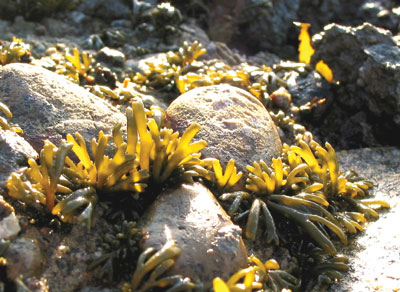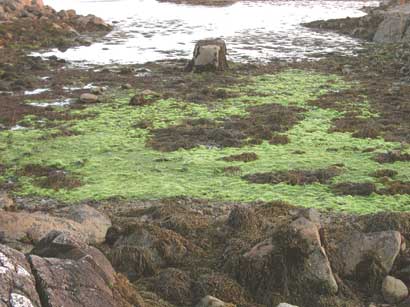Despite their traditional uses as fertilisers, animal foods and as additives in human nutrition, seaweeds generally have a bad reputation as they cause unpleasant smells when washed up and rotting on our beaches. However, the fact is, they also can act as very sensitive biological indicators that allow scientists to detect changes in the environment. Such changes include not only local eutrophication caused by high nutrient inputs and effluents from the land, but also recent changes in our climate.
As photosynthetic organisms, seaweeds absorb light using pigments, and it is small fluctuations in pigment concentrations and composition, which can be detected within hours, that allow researchers to monitor local temperature, irradiance and nutrient regimes. Scientists in the Departments of Botany, MRI, and Experimental Physics at NUI Galway are investigating how pigment bleaching in seaweeds from the west of Ireland may be linked to unusually high levels of UV-radiation, likely to be related to global climate change due to depletion of the ozone layer. The effects of climate change on commercially exploited species (e.g. the knotted wrack
Ascophyllum nodosum
) are also investigated as part of an EPA-funded Cluster Project (
www.BioChange.ie
).
 Other biological marker molecules used in assessing environmental parameters are phenolic compounds, since some seaweeds can adjust their internal levels in response to their surroundings. The potential of phenols as useful biomarkers is currently investigated by postdoctoral fellow Dr Solene Connan (Department of Botany, ECI&MRI) funded by the EPA. Brown seaweeds (like kelps and wracks) use phenols to bind metals, as defence against herbivores and also as protective compounds against high radiation (e.g. UV) stress. Understanding the control of phenol levels and composition will provide clues to the environmental history of the seaweed, and this knowledge can be applied in environmental monitoring. Collaborative research with the University of Western Brittany, Brest, allows the NUI Galway team to characterise phenols in relation to particular environmental conditions, linking them to their biological function. As a bonus, seaweed-derived phenolics have many industrial applications in the pharmaceutical and food industries; this means that investigating their control and composition is very promising not only from an environmental, but also a commercial point of view.
Other biological marker molecules used in assessing environmental parameters are phenolic compounds, since some seaweeds can adjust their internal levels in response to their surroundings. The potential of phenols as useful biomarkers is currently investigated by postdoctoral fellow Dr Solene Connan (Department of Botany, ECI&MRI) funded by the EPA. Brown seaweeds (like kelps and wracks) use phenols to bind metals, as defence against herbivores and also as protective compounds against high radiation (e.g. UV) stress. Understanding the control of phenol levels and composition will provide clues to the environmental history of the seaweed, and this knowledge can be applied in environmental monitoring. Collaborative research with the University of Western Brittany, Brest, allows the NUI Galway team to characterise phenols in relation to particular environmental conditions, linking them to their biological function. As a bonus, seaweed-derived phenolics have many industrial applications in the pharmaceutical and food industries; this means that investigating their control and composition is very promising not only from an environmental, but also a commercial point of view.

Contact: Dr Dagmar Stengel, Department of Botany,
Martin Ryan Institute, NUI Galway.
E-mail:
[email protected]
|


